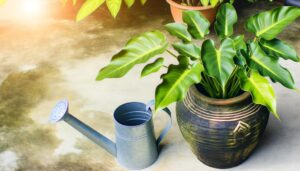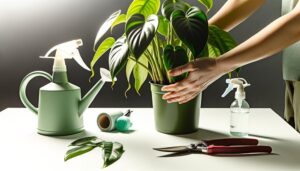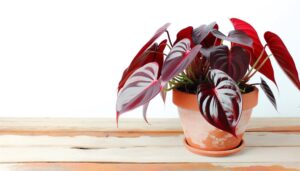How Do You Care for Philodendron Hope? A Complete Guide!
Philodendron Hope needs bright, indirect light, ideally within 10,000 to 20,000 lux. Maintain ambient temperatures between 65°F and 80°F, avoiding extremes that cause stress.
Optimum humidity levels range between 60% and 80%, monitored with a hygrometer. Water when the top 2 inches of soil are dry, using tepid, filtered water.
Utilize a well-draining soil mix made of peat moss, perlite, and orchid bark, ensuring a pH of 5.5 to 6.5. Prune with sterilized shears and wipe leaves with a damp cloth to enhance photosynthesis.
Monitor for pests like spider mites and aphids, using neem oil as a preventive measure. Delve deeper for thorough care strategies.

Key Takeaways
- Place Philodendron Hope in bright, indirect light near east or west-facing windows.
- Maintain ambient temperature between 65°F to 80°F and humidity levels between 60% and 80%.
- Water when the top 2 inches of soil are dry, using tepid, filtered water.
- Use a well-draining soil mix containing peat moss, perlite, and orchid bark.
- Prune overgrown stems and clean leaves regularly to enhance air circulation and photosynthesis.
Light Requirements
Philodendron Hope thrives in bright, indirect light, needing around 10,000 to 20,000 lux for best photosynthesis and growth. Position the plant near east or west-facing windows, making sure it receives filtered sunlight. Avoid direct sunlight, which can cause photodamage and chlorosis.
Use a light meter to monitor lux levels accurately. In low-light conditions, consider supplemental lighting, such as fluorescent or LED grow lights, to maintain ideal illumination. Implementing a photoperiod of 12-14 hours of light per day can improve the plant’s physiological processes.
Regularly rotate the plant to ensure even light distribution, preventing etiolation. This attention to precise light requirements will support strong morphological development and vibrant foliage, essential for those dedicated to excellence in plant care.
Watering Schedule
In addition to precise light management, maintaining an ideal watering schedule is essential for ensuring the health and vigor of Philodendron Hope.
This plant thrives in consistently moist, but not waterlogged, soil. To achieve best hydration, water when the top 2 inches of the substrate feels dry to the touch.
Utilize a watering can with a fine spout to evenly distribute water, ensuring complete saturation without pooling. Avoid over-watering, as excess moisture can lead to root rot and other phytopathological issues.
Seasonal variations necessitate adjustments; reduce watering frequency during dormancy periods, typically in winter.
Employ tepid, filtered water to prevent mineral buildup and temperature shocks, promoting robust growth and longevity for this botanical specimen.
Ideal Soil Mix
A well-draining, aerated soil mix made up of equal parts peat moss, perlite, and orchid bark provides the ideal medium for Philodendron Hope cultivation. Peat moss retains moisture without becoming waterlogged, ensuring consistent hydration.
Perlite enhances drainage and aeration, preventing root rot. Orchid bark, rich in organic matter, promotes root breathing and mimics the plant’s natural epiphytic habitat.
Maintain the soil pH at a slightly acidic level, around 5.5 to 6.5, to facilitate optimal nutrient uptake. Regularly monitor the soil’s compaction and amend with fresh components as needed to maintain its structure.
This strategic soil composition supports vigorous growth, robust root systems, and overall plant health, catering to the needs of those dedicated to cultivating thriving Philodendron Hope specimens.
Temperature Needs
Maintaining an ambient temperature within the range of 65°F to 80°F (18°C to 27°C) is essential for the ideal growth and physiological functions of Philodendron Hope. Deviations from this temperature range can result in stunted growth or stress responses.
Cold stress occurs below 55°F (13°C), potentially leading to chlorosis and necrosis of foliage. Conversely, temperatures exceeding 85°F (29°C) may accelerate transpiration rates, causing desiccation. Utilize a digital thermostat to monitor and regulate temperature precisely.
For environments subject to temperature fluctuations, consider employing horticultural heating mats or cooling fans to stabilize conditions. It is paramount to avoid sudden temperature changes, as these can disrupt cellular functions and reduce overall plant vigor.
Humidity Levels
Optimum humidity levels for Philodendron Hope range between 60% and 80%, as higher humidity supports the plant’s transpiration and nutrient uptake processes.
To maintain these essential conditions, consider the following methods:
- Mist the foliage regularly with distilled water to replicate the plant’s native tropical environment.
- Employ a humidifier in the room to consistently increase ambient moisture levels, guaranteeing the air remains saturated.
- Position the plant on a humidity tray filled with water and pebbles, which will evaporate and moisten the immediate area around the plant.
These practices not only enhance the plant’s physiological functions but also contribute to its overall health and vigor. Accurate monitoring using a hygrometer ensures your Philodendron Hope thrives in its ideal microclimate.
Fertilizing Tips
To achieve peak growth, Philodendron Hope requires a balanced, water-soluble fertilizer with an N-P-K ratio of 20-20-20, applied bi-weekly during the active growing season from spring to early autumn.
During the dormant winter months, reduce fertilization to once every six to eight weeks to prevent nutrient overload and potential root damage.
Monitoring soil pH and maintaining it within the ideal range of 5.5 to 6.5 will further improve nutrient uptake efficiency.
Optimal Fertilizer Types
Selecting the appropriate fertilizer for Philodendron Hope involves understanding its specific nutrient requirements and growth patterns. This tropical plant thrives on a balanced nutrient diet to maintain lush, vibrant foliage. Utilizing a water-soluble fertilizer with an NPK ratio of 20-20-20 is recommended for general maintenance.
To cater to the plant’s needs and promote robust growth, make sure the fertilizer contains:
- Micronutrients such as iron, manganese, and zinc, which are essential for chlorophyll production and enzyme function.
- Slow-release formulations that provide a steady nutrient supply without the risk of over-fertilization.
- Organic options like fish emulsion or worm castings, which enrich the soil microbiome and support sustainable growth.
Seasonal Fertilizing Schedule
Understanding the best fertilizer types is only part of the equation; implementing a precise seasonal fertilizing schedule is equally critical to guarantee Philodendron Hope receives the nutrients it needs throughout the year.
During the active growing season, typically from spring to early autumn, administer a balanced, water-soluble fertilizer with an N-P-K ratio of 10-10-10 bi-weekly.
In contrast, reduce fertilization frequency to once monthly during the dormant winter months, utilizing a diluted solution at half strength. Confirm even distribution by watering thoroughly post-application to prevent root burn.
Regularly monitor soil pH, maintaining a range of 5.5 to 6.5, to optimize nutrient uptake. Adherence to this regimen fosters robust growth and vibrant foliage, essential for serving the aesthetic and health needs of this tropical plant.
Pruning and Maintenance
Pruning and maintenance of Philodendron Hope involve the systematic removal of necrotic foliage, precise trimming of excessively elongated stems, and regular decontamination of the plant’s surface.
Utilizing sterilized pruning shears, excise any dead or yellowing leaves to prevent pathogen proliferation. Additionally, employ a soft cloth moistened with water to eliminate dust and particulate matter from the leaves, ensuring best photosynthetic efficiency.
Remove Dead Leaves
Regularly removing dead leaves from your Philodendron Hope is crucial for maintaining its health and promoting ideal growth. Begin by inspecting the plant for senescent foliage, characterized by yellowing or browning leaves.
Using sterilized pruning shears, excise the dead tissue at the base of the petiole to prevent pathogen ingress. This meticulous practice not only enhances aesthetic appeal but also redirects essential nutrients to healthy parts of the plant.
- Prevent Disease: Removing necrotic leaves reduces the risk of fungal and bacterial infections.
- Promote Growth: Clearing dead foliage allows the plant to allocate resources more efficiently.
- Enhance Appearance: Maintaining a pristine plant fosters a sense of tranquility and well-being.
Trim Overgrown Stems
After eliminating dead leaves, tending to overgrown stems through strategic trimming is equally crucial for the best well-being and structural integrity of your Philodendron Hope. Utilize sterilized pruning shears to lessen the risk of pathogen transmission.
Focus on stems showing excessive lengthening or those disturbing the plant’s aesthetic balance. Trim right above a node to stimulate new growth and maintain a compact shape. Make sure to remove no more than one-third of the plant’s foliage at a time to avoid unnecessary stress.
Pruning also enhances air circulation, reducing the chances of fungal infections. Regularly examine and trim during the active growing season for optimal outcomes. This careful approach guarantees the physical well-being and visual attractiveness of your Philodendron Hope.
Clean Plant Regularly
To ensure the longevity and health of your Philodendron Hope, consistent cleaning and maintenance are vital. Regularly removing dust from leaves is necessary as it enhances photosynthesis and prevents pests. Employ a damp, soft cloth to gently wipe each leaf, ensuring no abrasive materials are used that could damage the plant’s cuticle.
Additionally, pruning is essential for maintaining best plant health and encouraging new growth. Utilize sterilized pruning shears to excise any yellowing or damaged foliage.
Key benefits of regular cleaning include:
- Improved air circulation: Promotes a healthier growing environment.
- Pest prevention: Reduces the likelihood of infestations.
- Aesthetics: Keeps the plant visually appealing and vibrant.
These practices foster a thriving, aesthetically pleasing Philodendron Hope, aligning with your goal to care for others.
Repotting Guide
Repotting Philodendron Hope involves carefully transferring the plant to a new container to accommodate its growing root system, guaranteeing best soil composition and adequate drainage. Select a pot 2 inches larger in diameter than the current one.
Use a well-draining potting mix, such as a blend of peat, perlite, and pine bark. Gently remove the plant, ensuring minimal root disturbance. Place the plant in the new pot and fill with soil, making sure roots are covered but not compacted. Water thoroughly after repotting to settle the soil and eliminate air pockets.
| Step | Description | Tips |
|---|---|---|
| 1. Select Pot | Choose a pot 2 inches larger | Ensure proper drainage |
| 2. Prepare Soil | Use a mix of peat, perlite, and pine bark | Avoid dense, compact soils |
| 3. Transfer Plant | Gently remove and replant | Minimize root disruption |
| 4. Watering | Water thoroughly post-repotting | Check for air pockets |
Common Pests and Issues
Philodendron Hope is susceptible to several common pests and issues, including spider mites, aphids, and root rot, which can be managed through vigilant monitoring and appropriate treatment protocols.
Spider mites and aphids can be eradicated using a neem oil solution or insecticidal soap, ensuring thorough coverage of all plant surfaces.
Root rot, often caused by overwatering or poor drainage, necessitates the removal of affected roots and repotting in well-aerated, sterile soil.
- Spider mites: Apply neem oil solution every two weeks.
- Aphids: Utilize insecticidal soap and isolate the plant.
- Root rot: Trim infected roots, repot in well-drained soil.
Implementing these measures will help maintain plant health and vigor, ensuring ideal growth conditions for Philodendron Hope.
Does Hope Philodendron Die In The Winter Months
Hope Philodendron (Philodendron bipinnatifidum) can survive the winter months if kept in the right conditions. It is a tropical plant and does not tolerate frost or cold temperatures. If temperatures drop below 50°F (10°C), the plant can suffer damage or die.
To ensure its survival during winter:
- Indoors: Bring the plant indoors where it can be kept in a warm environment with plenty of indirect sunlight.
- Outdoors: If kept outdoors, ensure it is in a sheltered spot away from cold drafts and consider using frost protection covers.
Proper care, including maintaining appropriate temperature and humidity levels, will help keep your Hope Philodendron healthy through the winter months.
Conclusion
To sum up, the best care regimen for Philodendron Hope involves precise light requirements, a disciplined watering schedule, a well-draining soil mix, specific temperature and humidity levels, regular fertilization, pruning, and repotting practices, alongside vigilant pest management. Mastery of these elements guarantees robust growth and sustained health.
Attention to these guidelines will render the plant as strong and healthy as a 1950s Cadillac, exemplifying the peak of horticultural excellence and botanical well-being.






